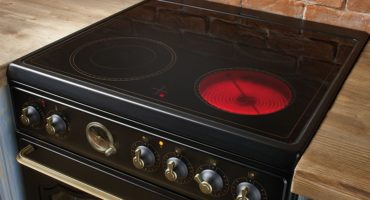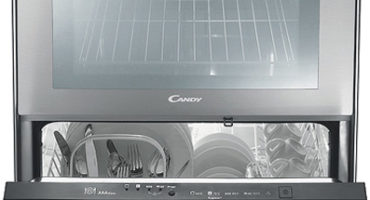- Choose the dimensions of the hob for 4 burners
- What and how should I choose so that the hob is in “its” place?
- Typical hobs and their sizes
- Custom dimensions
- Gas hob and its pros and cons
- Types of gas burners
- Electric hobs
- Heating elements of electrical devices
- Forms of heating elements
- Dependent Cooktops
- Advantages and disadvantages of dependent models
A modern hob is an accessory of competent kitchen design. She looks and works as an integral element of a single mechanism. No free-standing stove will look so organic and stylish as a special plane for cooking built into the overall interior of the kitchen.
Choose the dimensions of the hob for 4 burners
The most common today are four-ring kitchen units. And although voices are heard that four burners are just a tribute to the habit, in fact, all manufacturers produce kitchen appliances with four heating elements most of all. Therefore, from the whole variety, it is preferable to consider the dimensions of the hob precisely on 4 burners.
What and how should I choose so that the hob is in “its” place?
Considering the options you like, it is advisable to keep in mind the reasonable location of the device throughout the kitchen. To do this, you just need to adhere to simple rules and calculations.
So, it is recommended that the distance from the sink to the cooking zone should be at least 50 cm. If it is less, then cooking products in this space, you can burn yourself from the cramped hot dishes next to them due to cramped space.
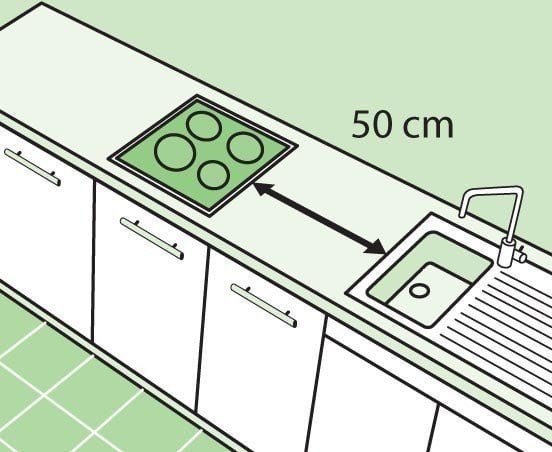
Washing distance - at least half a meter
It is also desirable that the sink should be no further than 1 meter. In the process of cooking, you have to constantly move from the cooking zone to the sink and back. A long distance will make you take extra steps and waste time. If the surface is located close to the wall, then the distance to the wall should not be less than 30 cm. Otherwise, a nearby wall will not allow convenient removal of dishes standing on the stove.
Do not forget that the kitchen during cooking must be ventilated. As a rule, all kitchen units operate simultaneously with a hood. And it is desirable that the dimensions of the hood correspond to the area of the cooking space.
Typical hobs and their sizes
The choice of device dimensions is easiest to start by considering the most typical values. If there is no desire to make it original, and the layout of the kitchen does not require strict restrictions on the parameters, then there will be a majority of options in standard catalogs and Internet sites with standard values.
What are the dimensions and what values can be considered typical?
It is not necessary to understand the quoted average figures "to the nearest millimeter." If it is said that the standard is 500 mm, then this value is approximate. For different manufacturers and in different samples, it will slightly differ in one direction or another. Maybe 480, and 520.
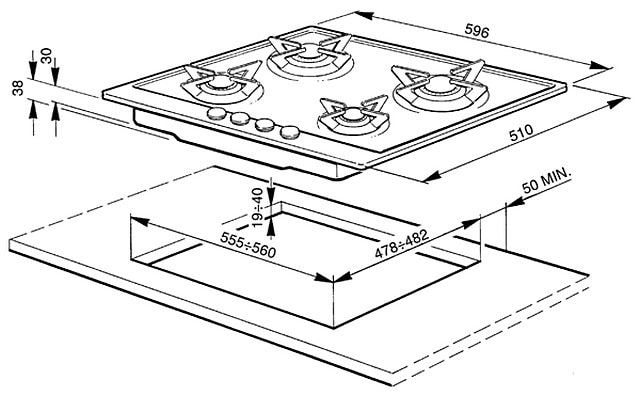
Typical dimensions
The figure shows the values that are most common among all types and models. Although only the modification for gas is shown, this does not matter, since for electrical samples these values are practically no different.
- Depth. In the figure, it is 510 mm. The least modifiable parameter. The vast majority of specimens have a depth of 500-530 mm. A typical kitchen worktop has a width of 60 cm.The specified depth allows you to insert the device into the countertop in compliance with the required distances from the walls of the kitchen.
- Thickness. In the figure, it is 38 mm. Also not the most influential parameter. In some brief characteristics, it is not even indicated. Typically, the thickness is 40-50 mm. This is consistent with the standard tabletop thickness of 38 mm. But there are specimens up to 100 mm thick. The use of a device of this thickness not only reduces the space below it, but also requires the installation of a special jumper shelf. This shelf prevents accidental damage to the recessed part.
- Width. The number 596 in the picture. It also has its own standards. The most common widths for 4-burner panels are approximately 600 mm. It is rare to find a width of 50 cm. There are more - there are, but still mostly 70 centimeters or more width for five burners. Typically, significant variations in width are associated with a change in the location of the controls. They can be either frontally or sideways.
It’s useful to know that sometimes “dimensions for embedding” are also indicated in the specifications. They are smaller than overall. They are used in calculating the hole in the countertop, which is necessary for inserting a given sample into it. In the figure, these are sizes 478–482 and 555–560.
The table shows several real specimens with the corresponding dimensions:
| Title | Width | Depth | Thickness |
| For gas: | |||
| Electrolux EHT 60435 | 590 | 520 | |
| Bosch PCP 612B80E | 582 | 520 | 52 |
| Electric: | |||
| Zanussi ZVT 64 BV | 576 | 506 | 49 |
| Electrolux EHF96547FK | 590 | 520 |
Custom dimensions
Most manufactured cooking devices have a typical appearance - a square or rectangle. But also non-traditional and sometimes exotic forms are produced. Some of these options offer a solution for placement in non-standard conditions, usually with an acute lack of space. This type includes, for example, surfaces with a linear arrangement of burners.
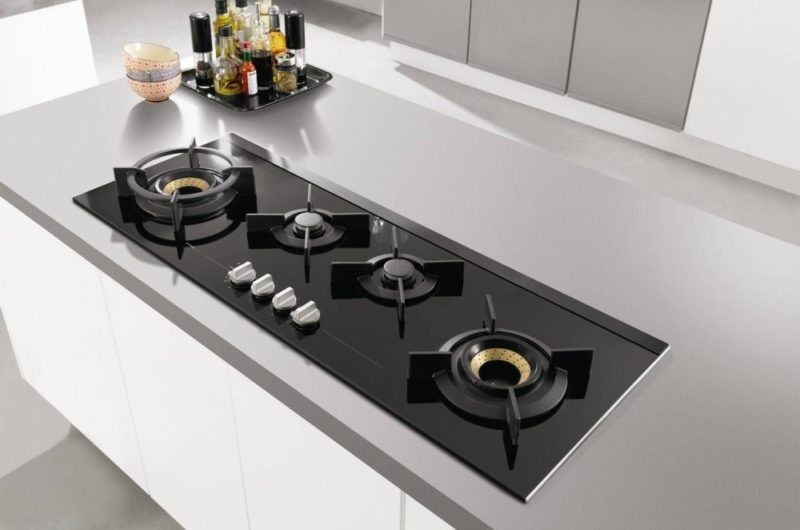
Linear arrangement
In this case, the width increases significantly, but the depth also halves. The depth may not exceed 30 cm, but the width is 90-100 cm. In some cases, the width reaches 118 cm. This form is absolutely indispensable when installing the device in a narrow tabletop.
Another non-standard way of placement is in the corner of the kitchen. Of course, in the corner of the tabletop you can "fit" and the usual rectangular plane. But it will most likely look like just an attempt to show originality. Or as a sudden change in layout after the purchase of the device.

Standard module located in the corner
At the same time, models are designed specifically for corner installation.
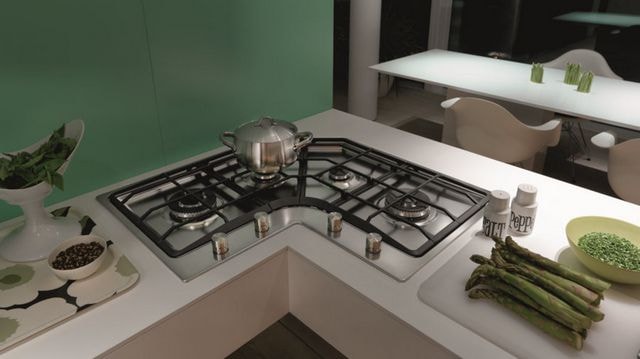
Special corner module
There are also samples of just the original form. This has its advantages and disadvantages. The new original design will help reduce fatigue from a permanent stay in the kitchen. But you also have to get used to the unexpected location of the burners.
Original options include those with an oval shape and curved ones resembling a boomerang in appearance.
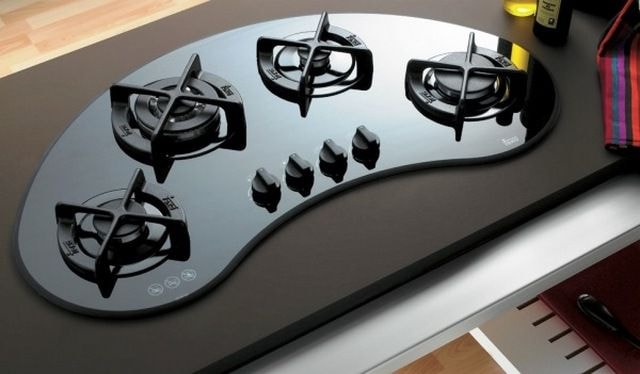
Original look - "boomerang"
Gas hob and its pros and cons
The advantages of gas-fired kitchen appliances are:
- Warming up begins and ends immediately. No waiting at the beginning and cooling at the end;
- The change in intensity also occurs instantly;
- Low cost of the device and gas consumed.
The disadvantages include:
- Relatively low safety - open fire, the possibility of gas leakage;
- The comparative complexity of maintaining cleanliness.
The problems of open fire and gas leaks at the modern level are solved by the installation of automatic ignition systems and combustion control. The gas control system shuts off the gas supply during unauthorized attenuation of the flame in the burner.
Recently, gas appliances have begun to be produced in which there is no direct contact of flame and utensils.These are gas panels with glass ceramics, or, as they are also called, “gas under glass”.
In such samples, gas combustion occurs in a closed chamber, and thermal energy is transferred to the ceramic surface. There are no dangers arising from the use of open flame. And the products of gas combustion by the ventilation system are brought out. But while such models in the Russian market are very rare.
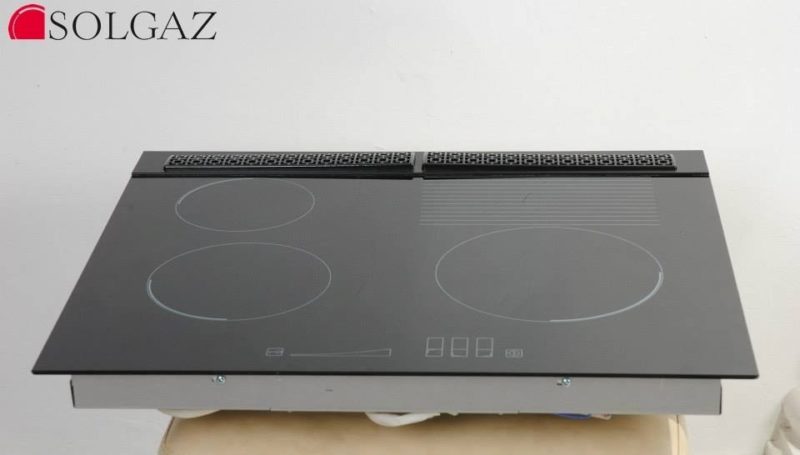
Gas under glass
Types of gas burners
- As a rule, burners of different diameters are used in gas devices. At least one burner - of large diameter and, accordingly, of greater power. Designed for quick heating or for heating large volumes.
- Also, to increase the heating rate, burners with two or three rows of flame are used.
- WOK burners. These are special burners that, in addition to double rows of fire, have a surface that allows cooking in dishes with a convex bottom.
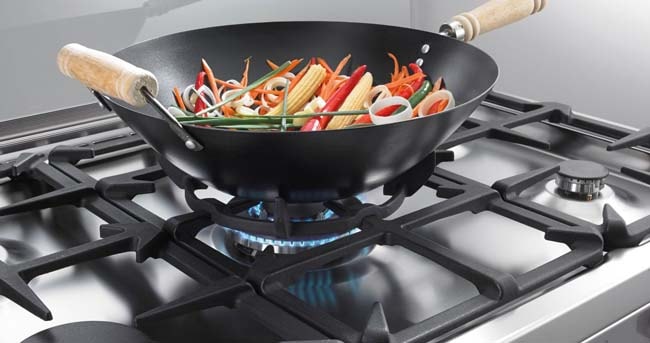
For convex bottoms
Electric hobs
The main advantages that the electric model provides:
- Security. Lack of open flame and possible gas leakage;
- Exact adjustment of the intensity of heating;
- Completely flat surface without any protrusions. It looks elegant. Surface care and cleaning is much easier.
Disadvantages of electrical models:
- Inertia in work. Heating units do not immediately give the required temperature, and when turned off, they do not immediately cool down;
- Electric models are usually more expensive than gas;
- For efficient heating, flat bottom cookware is needed.
Do not pay special attention to the fact that outwardly most electric models look exactly the same. They represent a flat glass-ceramic surface, most often black. And all the blocks and controls are under it. The fact is that only two companies produce such glass ceramics - the German Shott and the French Corning. And supply them to all manufacturers of kitchen appliances.
Heating elements of electrical devices
The main types of heating elements:
- Cast-iron “pancakes” with spirals inside. This is exactly the option in which the heaters do not close with a ceramic platform, but stick out from the outside. The cheapest type, but also the most unaesthetic and quite whimsical to use
- Tape heaters. The most common type. The disadvantages include the difficulty of accurately maintaining the required temperature. When turned on, the elements operate at full power, and when they reach the set temperature they turn off. Then the process is repeated.
- Halo-Light - heating elements based on tubes filled with gas. To date, relatively rare.
- Induction heating method. Pretty expensive, but the most technologically advanced. Cookware mounted on a ceramic platform is heated by induction currents that occur when the magnetic field of the induction coil interacts with the metal of the cooked dishes. Very convenient in the sense of protection against accidental switching on. In the absence of dishes on the stove, there simply cannot be any heating. But even cooking utensils are not suitable for cooking. Aluminum pots and bowls this unit will not heat.
Forms of heating elements
The most common form is, of course, the circle. The circles can be of different diameters and, accordingly, of different capacities. There are also oval heating zones.
Quite often, heating blocks with two, sometimes with three heating zones are used. Using the handles or control sensors, you can increase or decrease the heated area. Additional zones can be of the same shape, but larger, or the shape of the heating surface can change - from a circle to an oval and vice versa.
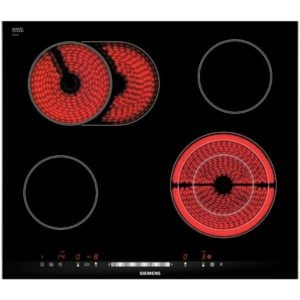
Variable burner areas
Dependent Cooktops
Separately, it is worth considering the so-called dependent surfaces.Actually, this is a common option, and its dependence is that it is installed necessarily complete with an oven.
Most often, in the dependent tandem, the same type of oven and cooking is used - electric or gas. But there are also combined models - for example, a gas dependent surface and electric oven. The controls of both components of the combination are combined into one common unit. It is usually located on the wall of the oven.

Dependent hob
Advantages and disadvantages of dependent models
In fact, there is one advantage - they are cheaper than separately purchased independent components. The disadvantages are slightly larger:
- Since both the oven and the cooking panel depend on each other, it is impossible to combine models from different manufacturers into one node.
- Geographically, they are also located in one place and in a single unit - the hob above the oven. If the dependent tandem is electric, then, in principle, it is possible to distribute its components in separate places. But this will require additional installation effort — for example, extending control wires. Such changes must necessarily take place under the control of the manufacturer.
- In the event of a malfunction in the control unit - the kitchen immediately loses the ability to cook and bake.


